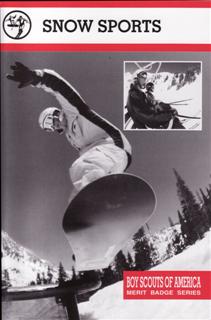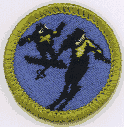- Discuss winter sports safety, and show that you know first aid for injuries or illnesses that could occur while skiing or riding, including hypothermia, frostbite, shock, dehydration, sunburn, fractures, bruises, sprains, and strains. Tell how to apply splints.
- Explain why every skier or snowboarder should be prepared to render first aid in the event of a skiing an accident.
- Explain the procedure used to report an accident to the local ski patrol for the area where you usually ski or ride.
- Tell the meaning of the Your Responsibility Code for skiers and snowboarders. Explain why you must follow this code.
Do EACH of the following:- Tell the meaning of the Your Responsibility Code for skiers and snow-boarders. Explain why each rider must follow this code.
- Explain the Smart Style safety program. Tell why it is important and how it applies to skiers and snowboarders in terrain parks and pipes.
- Explain the precautions pertaining to avalanche safety, including the responsibility of individuals regarding avalanche safety.
- Tell the meaning of the Wilderness Use Policy. Explain why each skier and snowboarder must adopt this policy.
- Complete all of the requirements for ONE of the following options:
downhill (Alpine) skiing or
cross-country (Nordic) skiing or
snowboarding.
- Downhill (Alpine) Skiing
- Show how to use and maintain your own release bindings and explain the use of two others. Explain the international DIN standard and what it means to skiers.
- Explain the American Teaching System and a basic snow-skiing progression.
- Explain and discuss the following:
- Five types of Alpine skis
- Telemark skis
- Snowboards
d. Name the major ski organizations in the United States and explain their functions.
- Discuss the five types of Alpine skis. Demonstrate two ways to carry skis and poles safely and easily.
- Explain the importance of strength, endurance, and flexibility in downhill skiing. Demonstrate exercises and activities you can do to get fit for skiing.
- Do the following:
1. Present yourself properly clothed and equipped for downhill skiing. Discuss how the clothing you have chosen will keep you warm and protected.
2. Demonstrate two ways to carry skis and poles safely and easily. - Demonstrate how to ride one kind of lift and explain how to ride two others.
- Explain the international trail-marking system.
- On a gentle slope, demonstrate some of the beginning maneuvers learned in skiing. Include the straight run, gliding wedge, wedge stop, sidestep, and herringbone maneuvers.
- On slightly steeper terrain, show linked wedge turns.
- On a moderate slope, demonstrate five to 10 christies.
- Make a controlled run down an intermediate slope and demonstrate the following:
- Short-, medium-, and long-radius parallel turns
- Sideslip A sideslip and safety (hockey) stop to each side
- Traverse across a slope
- Demonstrate the ability to ski in varied conditions, including changes in pitch, snow conditions, and moguls. Maintain your balance and ability to turn.
- Cross-Country (Nordic) Skiing
- Tell the meaning of the Wilderness Use Policy. Explain why each skier must adopt this policy.
b. Show your ability to select, use, and repair, if necessary, the correct equipment for ski touring in safety and comfort. - Discuss classical and telemark skis. Demonstrate two ways to carry skis safely and easily.
- Discuss the basic principles of waxing for cross-country ski touring.
- Discuss the differences between cross-country skiing, ski touring, ski mountaineering, and downhill skiing.
- Explain the importance of strength, endurance, and flexibility in cross-country skiing. Demonstrate exercises and activities you can do to get fit for skiing.
- List items you would take on a one-day ski tour.
- Present yourself properly clothed and equipped for a one-day ski tour. Discuss the correct use of your clothing and equipment , and how the clothing you have chosen will keep you warm and protected.
- Demonstrate the proper use of a topographic map and compass.
- Show a degree of stamina that will enable you to keep up with an average ski-touring group your age.
- On a gentle, packed slope, show some basic ways to control speed and direction. Include the straight run, traverse, sideslip, step turn, wedge stop, and wedge turn maneuvers.
- On a cross-country trail, demonstrate effective propulsion by showing proper weight transfer from ski to ski, pole timing, rhythm, flow, and glide.
- Demonstrate your ability, on a tour, to cope with an average variety of snow conditions.
- Demonstrate several methods of dealing with steep hills or difficult conditions. Include traverses and kick turns going uphill and downhill, sidesteps, pole drag, and ski-pole "glissade."
- Tell the meaning of the Wilderness Use Policy. Explain why each skier must adopt this policy.
- Snowboarding
- Discuss forward-fall injuries. Tell about prevention and what action must be taken in the event of any type of injury or accident.
- Do the following:
- Demonstrate your ability to select the correct equipment for snowboarding and to use it for safety and comfort.
- Present yourself properly clothed and equipped for snowboarding. Discuss how the clothing you have chosen will keep you warm and protected.
- Demonstrate how to carry a snowboard easily and safely.
- Show how to use and maintain your own bindings, and explain the use of the different binding methods. Explain the need for leashes.
- Discuss the four types of snowboards. Demonstrate how to carry a snowboard easily and safely.
- d. Demonstrate exercises and activities that will get you fit for snowboarding.
- e. Demonstrate how to ride one kind of lift and explain how to ride two others.
- f. Explain the international trail-marking system.
- g. Demonstrate the basic principles of waxing a snowboard.
- Do the following:
- h. On a gentle slope, demonstrate beginning snowboarding maneuvers. Show basic ways to control speed and direction. Include the sideslipping maneuver.
- i. On slightly steeper terrain, show traversing.
- On a moderate slope, demonstrate an ollie, a nose-end grab, and a wheelie.
- Make a controlled run down an intermediate slope and demonstrate the following:
- Skidded, carved, and jump turns
- Stops
- Riding fakie
- Demonstrate your ability to ride in varied conditions, including changes in pitch, snow conditions, and moguls. Maintain your balance and ability to turn.
- Name the major snowboarding organizations in the United States and explain their functions.
- Downhill (Alpine) Skiing
BSA Advancement ID#:
135
Requirements last updated in:
2007
Pamphlet Publication Number:
33365B
Pamphlet Revision Date:
2005
| Worksheets for use in working on these requirements: | Format | |
|---|---|---|
| Word Format | PDF Format | |
Page updated on: December 17, 2023









